|
Gardens Ablaze |
||
|
|
Tulips
|
DirectGardening.com |
|
Detailed Bulb Profiles Site Map
Home |
 Tulips
are synonymous with springtime, and along with Daffodils, are among the
most popular springtime bulbs. They come in such a huge array of colors,
bloom times, and sizes that you could conceivably plant nothing but tulips
and have a traffic-stopping garden for over three months. Tulips
are synonymous with springtime, and along with Daffodils, are among the
most popular springtime bulbs. They come in such a huge array of colors,
bloom times, and sizes that you could conceivably plant nothing but tulips
and have a traffic-stopping garden for over three months.
Tulips are easy plants to grow, but plant them as soon as possible after buying the bulbs, because improper storage can damage or kill the bud and bulb. They are not picky about soil, but don't like wet feet, so build the soil up for drainage so they won't rot. They will do well in sun or part shade, and appreciate an application of bonemeal or superphosphate at planting time. Plant them in the fall, if possible, or buy the bulbs in early spring and chill in the crisper of the refrigerator for 6-8 weeks. Tulips require this chilling off process in order to bloom. Keep ripening fruit away from the bulbs if you are chilling them in the refrigerator, or the buds may be damaged. Planting depth for tulips is dependent on the size of the bulb. The larger bulbs should be planted 4-5 inches down, and obviously, the smaller bulbs should be planted closer to the surface. If you plan on leaving tulips in the ground permanently, do not cut the foliage back until it has turned brown, but don't count on a spectacular spring show every year from this planting, as these plants only bloom reliably for a few years, and then require replanting. There are many different types of tulips, from the small wild tulips that make nice additions to rock gardens, to the large Darwins and Parrot Tulips. Darwins are probably the most sought after of the tulip species, because they come in every color of the rainbow, including black. They are long-stemmed and make good cut flowers and make very attractive mass plantings in the garden, explaining their ever-growing popularity with home gardeners. If you haven't tried tulips in your garden, now is the time to experiment. Tulips can be planted at any point in the fall or early winter as long as the ground is not frozen. Beware, however, that if you have a deer problem or if you have rodents or burrowing animals on or around your property, your tulips plantings will not survive until bloom time, no matter what you try to do. Animals love these plants. Most of us are unaware that tulip bulbs are also safe for human consumption, but in this era, most of us are more interested in them for their blooms than as a vegetable side-dish.
|
|
|
Gardens Ablaze |
||